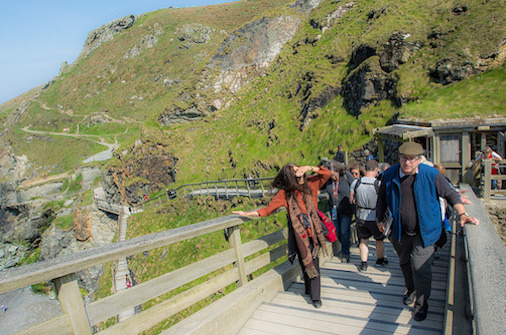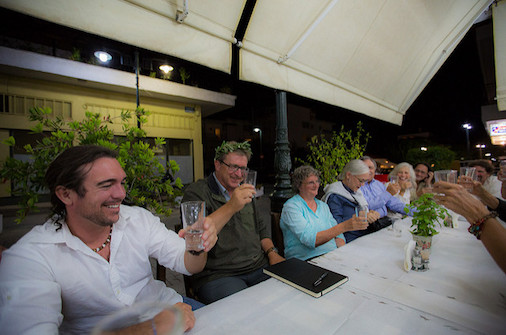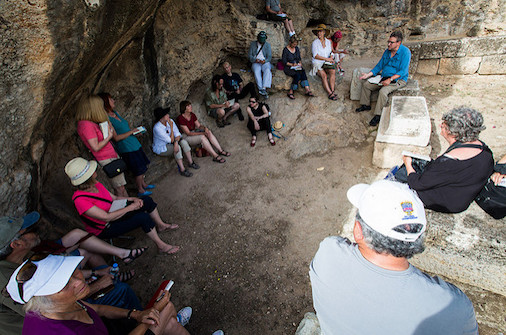Our Tour Leader Phil Cousineau sent us a copy of an interview he did with another of our Tour Leaders, Virginia Schenck, back in 2006. The interview is compelling reading, delving into the importance of pilgrimage in today’s fast-paced world and how critical it can be in the lives of the younger generation in particular. We’ve edited the original interview a little to make it easy to read in this blog format. Our thanks to both Phil and Virginia for sharing this insightful piece with us.
Virginia: What is it about a pilgrimage that calls out to us?
Phil: Traditionally, the call to pilgrimage came during either a spiritual crisis or an opportunity to fulfill a spiritual obligation. The long walk down what used to be called “the glory road” was meant to give a pilgrim ample time to contemplate deep issues that couldn’t be answered at home. Today, the call may even be more intense because life has become so frenetic that most of us claim not to have enough to think about spiritual issues on the traditional level, but also other deep concerns, such as failing marriages, job crises, or the general malaise. The cry for pilgrimage is an antidote to our over-amped lives.

Virginia: [In your book] The Art of Pilgrimage: The Seeker’s Guide to Making Travel Sacred, you talk about pilgrimage as being a “powerful metaphor for any journey” and a “universal quest for the self”. Would you expand on this?
Phil: When I wrote that pilgrimage is a powerful metaphor for any journey I meant that virtually any journey, whether a family vacation or a business trip, has the potential to be deeper, more meaningful, more purposeful. When interviewed by CNN about the book they asked if the book could be used by people who travel for business and I immediately responded, Yes, if they turned it into a micro-pilgrimage. By this I mean, time is short. For people who take their lives seriously, as a gift, as numinous, there’s no such thing as a “throw-away” trip, no such as thing as small talk. Every person you encounter is an angel in disguise, as the Greeks used to say; every journey has the potential to reveal the divine in life. If, that is, you pay attention, have the intention.
Of course, sometimes we want to just relax. But the potential is always there.
And yes, pilgrimage as “universal quest for the self” is a reference to the mythic dimension of the sacred journey. For me, all art, drama, and myth reveal the various means human beings use on the search for the self. In that sense, pilgrimage provides a road map, the physical counterpart to the psychological search.

Virginia: Also in The Art of Pilgrimage you outline several ways to make the pilgrim’s way sacred, to practice “the art of seeing” such as choosing a theme, journaling, and drawing. Do you have more to suggest for the young pilgrim?
Phil: Just because young people aren’t accustomed to writing or drawing doesn’t mean they shouldn’t try. Almost without exception, young people who are at least nudged will learn far more about themselves and the world if they learn to exercise these unused muscles. Otherwise, travel, even pilgrimage, for young people becomes little more than one more video game. Remember, the danger is passivity, for adults as well as youth. That’s the tourist-trap, not just rip-off joints. The trap is passivity, which is a nice way of saying voyeurism. So anything that turns us into active travelers helps move us toward pilgrimage.
However, the other track is ritual and ceremony. Ritualizing the entrance to a site. Walking in silence up the sacred way to Delphi; entering Notre Dame or a little shrine on the road to Santiago, puts us in what I like to think of as “the pilgrim mood,” which is one of respect, even reverence. Lighting a candle, singing songs, reading local poets, Neruda in Spain, Yeats in Ireland, etc. Reading sacred texts and discussing their merits, either alone or in a group also helps.

Virginia: In your book, Once and Future Myths: The Power of Ancient Stories in Our Lives, you devote an entire chapter to the importance of mentorship. You define a mentor as one who cares for the soul and seeks to draw out the best in his/her student. Is there more you could say about mentorship and the pilgrimage experience?
Phil: I ardently believe that pilgrimage is one of the greatest recommendations that a mentor can make. Traditionally, the shaman or elder recognized the transition moment from childhood to adulthood and announced to the child and the group that it was now time for the vision quest, the walkabout, the pilgrimage, the outer manifestation of the inner transformation. Today, for an adult spiritual counselor to take a youth on a pilgrimage is the very expression of saying, I want to help you more than tell you how to get a good job or get famous; I’m here to help you find yourself, “make up your own mind,” as the very meaning reveals. A youth recognizes the import of this: Wow, he or she is taking time out of their own lives to lead me on this journey!
Virginia: Once we’ve been on a pilgrimage, how do we carry that experience and newfound wisdom with us in our hearts, lives, and communities?
Phil: By keeping it alive. To do that you bring home real souvenirs, not fakes, by that I mean crafts, art, music, and especially something we’ve created out of it all. If our memories are in a shoebox under the bed or on a disc we’ll forget as surely as that dream that was never written down. Only by turning the journey into something new: a scrapbook, a journal, a story, poem, song or now what are called “soul boxes” then the trip will become – guaranteed – just one more hazy memory. If we don’t honour it, it, the memory, will fade, almost as if angry with us for not respecting it more. For millennia it was believed a returning voyager, adventurer, pilgrim, had an obligation to keep the story alive. That’s worth reviving.

Virginia: In your 1987 film A Hero’s Journey, a biography of noted mythology expert, Joseph Campbell, Campbell states that there isn’t a myth that fits our global world and people often regress to old groups, familiar ways. [Thirty] years later, have we found a myth that fits? Have we created one? If not, how do you see us faring in the world today?
Phil: Oh, but Joe also said, in my companion book to the film, and elsewhere, that there was and is indeed an emerging myth: The Myth of the Planet. Joe saw this in the early ’80s and is being proved prophetic. And to my lights this phenomenon of pilgrimage is one of the most profound manifestations of this vision. To take an authentic pilgrimage is a gesture to our personal and collective souls that the future will be determined by whether or not we, as human beings, stop demonizing the Other. As idealistic as this is, I think it’s virtually impossible to do so without either deep travel or prodigious reading. Otherwise, it’s a fatuous and amorphous idea. We have to have a meal in another culture, dance to their dances, worship in their places of worship, have a conversation that reveals our common humanity. Pilgrimage exhorts us to do this. And it’s the greatest gift we can give our youth. It was in this sense that the greatest American writer of all, Mark Twain, said, “Travel is the death of prejudice.”

If you’re inspired to take a journey of pilgrimage after reading this interview you can travel with Phil in 2020 with Sacred Earth Journeys.
Phil is leading a wonderful spring-time journey to Italy to discover one of the most artistic cultures in the world, you will become a cultural time traveller on a quest for La Dolce Vita: The Sweet Life of Mythic Italy with Phil Cousineau.